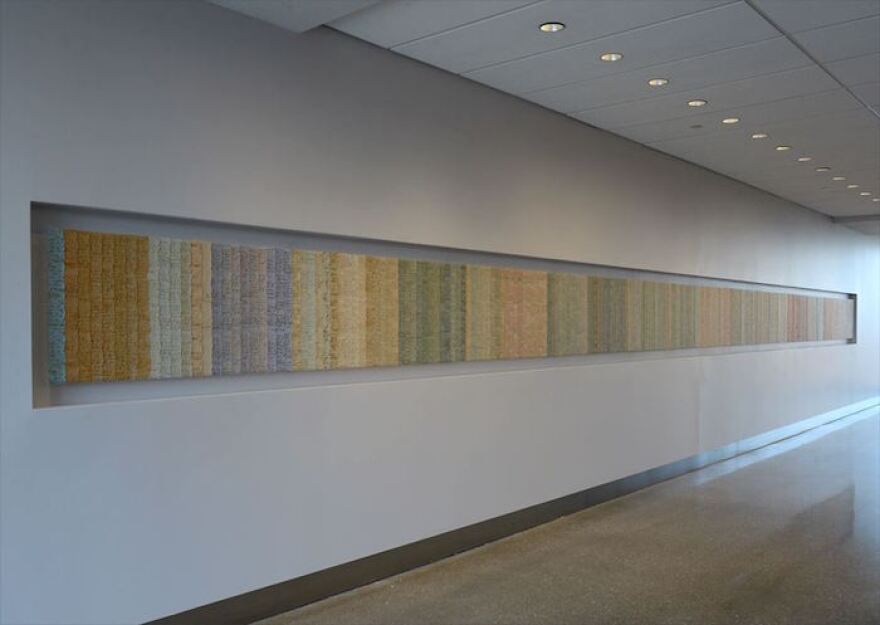Amid its ultramodern lecture halls, the University of Kansas Medical Center's new health education building is also a showcase for several Kansas City artists.
University leaders say the $82 million facility at the corner of 39th Street and Rainbow Boulevard, designed by Helix Architecture + Design, was shaped with student engagement in mind. But the years-long project also included formation of the University of Kansas Medical Center Art Commission. Saralyn Reece Hardy, director of KU's Spencer Museum of Art, and Leesa Fanning, contemporary art curator at The Nelson-Atkins Museum of Art, were among the architects and university administrators charged with locating artists for the project.
Six area artists ultimately contributed projects: Miki Baird, Marcie Miller Gross, Michiko Itatani, Jeremy Rockwell, Phil Shafer, and Jesse Small. KCUR asked three of them about their projects.
Miki Baird

Baird is a BFA and MFA alumni of the University of Kansas in Lawrence who has also taught at the Kansas City Art Institute.
Her piece for the Health Education Building takes advantage of the fact that the medical center's Clendening Library contains nearly 40 letters from Florence Nightengale, the founder of modern nursing. "For FN ... words without fear" uses images of Nightingale's handwritten letters on a 40-foot, horizontal timeline distinguished by handwriting and color.
Is there any difference in approach to creating depending on your audience?
"I always approach my work, regardless of the source, in the same way. I research a subject of interest that I can invest myself in and that I wholeheartedly feel is significant enough to extend to the viewer. It is important to me that no matter what the venue or purpose of making, that the viewer can find an interest in a relationship to the work."

Where did the inspiration for using Florence Nightingale letters come from and what is the message you're trying to convey in the title "words without fear"?
"Nightingale is recognized around the world as the founder of secular nursing during a time in history when healthcare for the common person was considered with disdain .... She was fearless, remaining focused during her lifetime as she developed efficient plans for basic healthcare and sanitation.
Her spirit, practicality and creativeness paralleled, nearly 200 years apart, a relationship to the intended purpose of KUMC's Health Education Building regarding its innovative teamwork and problem-solving dedicated to the successful practice of medicine.
I have been working with text for the past decade, and was intrigued by the visual beauty of her writing, the evolution over time of her hand and makers, the aging of her papers and by the content."
Phil Shafer

Shafer painted the walls around an ice cream shop on the building's first floor. It's a vibrant array of colors streaming through deep clouds of smoke surrounding a trajinera-style boat, referencing both the Mexican roots of Paleterias Tropicana as well as the fruity offerings available at the homestyle ice creamery.

Shafer has been working with the medical center's Kansas Intellectual and Developmental Disability Research Center designing and creating graphics since 2001. Through this project, his side work as a muralist collided with his day job in graphic design.
What do you find most enjoyable or difficult about being approached for collaboration projects or commissioned work?
"I enjoy the opportunity and challenge of each new job. There is always something new to learn or a technique to try out.
For most of my client murals, like the one in the new Health Education Building, I try to blend their brand identity with my graphic sense and find a blend that works best for the project. In this case my client was the Paleterias Tropicana, a Mexican-American owned ice cream and snack shop, for their newest location on the KUMC campus. I drew inspiration from the Mexican fruit markets as well as the lake boats from the Xochimilco area of Mexico."
Jesse Small

Jesse Small has a history in interviewing for and creating public sculptures around Kansas City.
"I really wanted to do the project," he said, "because it was going to be suspended from the ceiling. That's my jam."
His "Infinite Evolution" features 44 unique laser-cut steel panels, each perforated with designs inspired by drawings from "Micrographia," from 1665, the first book to illustrate the view of insects and plants as seen through a microscope.
Was there specific imagery you are trying to convey in the title "infinite evolution"?

"The name is meant to convey a general idea that there are no limits, and that, indeed, there is great mystery ahead. The phrase resonates with medical professionals because their understanding of the world is fact- and research-based. I anticipate that medical students will find inspiration in the idea that future medicines lie waiting to be invented as they dart beneath the sculpture at 2 a.m. to get more coffee.
A big part of my job is giving the project a name that others will be able to resonate with."
Is there any difference in approach to creating depending on your audience?
"Public art has significant engineering and group-work components that are not present when working towards a gallery show. But the difference is not in how the artist wonders what the audience will like or will not like; the difference is more about how the artist anticipates the theme of the general culture surrounding the work.
A large sculpture in a hospital better be about people's well being. It should not be a video projection or some off-the-shelf glass crap. People deserve way better than that."





